
This audio file plays a 60 second simulation of the signal the gravitational wave background from binary black hole and binary neutron star mergers would make in an ideal (noise-free) gravitational wave detector (such as LIGO or Virgo) which is sensitive to frequencies above 10 Hz. The average time between successive binary neutron star mergers is 13 seconds. Binary black hole mergers are less frequent, occurring every 223 seconds on average. Because of this, there is only one binary black hole merger starting at 20 seconds and ending at 34 seconds. The binary black hole is located at a redshift of 1.4 and is composed of black holes with intrinsic masses of 10 and 15 times the mass of the Sun.
The figure below is a visual representation of the audio file. It shows the temporal evolution of the detector strain in the absence of instrument noise as a function of time. The strain is a proxy for how much a gravitational wave causes the distance between the arms of the detector to shift. For more detail on the background signal from neutron stars and black holes see the main page.
Simulation of a gravitation wave background from one binary black hole and many binary neutron star mergers. The black hole merger can be clearly seen starting at 20 seconds and merging at 34 seconds.